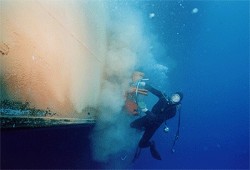
University of California
West Coast Ballast Outreach
Hull Fouling Research and Reports
While ballast water is often the primary vector of transer for many species/regions, hull fouling is now recognized as an important AIS vector, introducing more AIS than ballast water in some regions. Hull fouling as a serious problem is not surprising, considering:
2 Australian Quarantine and Inspection Service. 2005. AQIS Fact Sheet.
3 Godwin, L Scott (2003). Hull Fouling of Maritime Vessels as a Pathway for Marine Species Invasions to the Hawaiian Islands. Biofouling, 19 (1), 0892-7014.
- The wetted surface area (WSA) that arrives into the U.S. annually is equivalent to 2.5 times the area of Washington, D.C. (438 sq km). 1

- 67% of this WSA comes from outside the U.S.1
- 70% of the 250 Australia's AIS2 and 74% of Hawaii's AIS3 arrived via biofouling.
- Vessels may contain up to 90 tons of fouling.
- Simply cleaning the ship is not enough, as live organisms are often released into the water during this process (image at right).
Because vessel fouling has only recently been recognized as a significant vector of AIS introduction, research is limited but increasing. For a list of literature, see our AIS Literature page.
In addition, visit the Aquatic Bioinvasions Research and Policy Institute's project, Assessing Hull Fouling as a Vector of Invasive Species: A Case Study in the Lower Columbia River.
1 Smithsonian Environmental Research Center
2 Australian Quarantine and Inspection Service. 2005. AQIS Fact Sheet.
3 Godwin, L Scott (2003). Hull Fouling of Maritime Vessels as a Pathway for Marine Species Invasions to the Hawaiian Islands. Biofouling, 19 (1), 0892-7014.